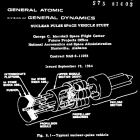 A report prepared by the Future Projects Office of NASA’s Marshall Spaceflight Center and General Atomic, the nuclear power division of General Dynamics, outlines in great detail ways that existing rocket technology (namely the Saturn V, which will not fly until 1967) and theoretical nuclear pulse propulsion technology could be combined to facilitate exploration of the moon and Mars. (Though derived from the Project Orion studies of the late 1950s, the potential nuclear-powered NASA program suggested in this document is not referred to as Orion.) The report, over 174 pages, goes into great detail about crew module design, radiation exposure, ways to mitigate the inevitable ablation of the “pusher plate” at the rear of the vehicle that will absorb a series of nuclear explosions at close range and translate the energy released into forward thrust, and even possible catastrophic launch abort modes, many of which would qualify as at least a small nuclear disaster. Even the health effects on civilian onlookers of a successful launch are considered, from retinal damage caused by viewing high-altitude firings of the nuclear propellant explosions to fallout risks, as well as potential collateral damage to satellites and non-hardened computers resulting from repeated electromagnetic pulses. The mission profiles considered are constrained to lunar missions and missions to Mars. (It’s worth noting that, by the time of this report’s issuance, the Nuclear Test Ban Treaty has been ratified by both the U.S. and the U.S.S.R., making it illegal to put nuclear pulse propulsion into practice.)
A report prepared by the Future Projects Office of NASA’s Marshall Spaceflight Center and General Atomic, the nuclear power division of General Dynamics, outlines in great detail ways that existing rocket technology (namely the Saturn V, which will not fly until 1967) and theoretical nuclear pulse propulsion technology could be combined to facilitate exploration of the moon and Mars. (Though derived from the Project Orion studies of the late 1950s, the potential nuclear-powered NASA program suggested in this document is not referred to as Orion.) The report, over 174 pages, goes into great detail about crew module design, radiation exposure, ways to mitigate the inevitable ablation of the “pusher plate” at the rear of the vehicle that will absorb a series of nuclear explosions at close range and translate the energy released into forward thrust, and even possible catastrophic launch abort modes, many of which would qualify as at least a small nuclear disaster. Even the health effects on civilian onlookers of a successful launch are considered, from retinal damage caused by viewing high-altitude firings of the nuclear propellant explosions to fallout risks, as well as potential collateral damage to satellites and non-hardened computers resulting from repeated electromagnetic pulses. The mission profiles considered are constrained to lunar missions and missions to Mars. (It’s worth noting that, by the time of this report’s issuance, the Nuclear Test Ban Treaty has been ratified by both the U.S. and the U.S.S.R., making it illegal to put nuclear pulse propulsion into practice.)
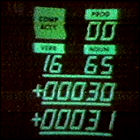 The first government contract is issued in the Apollo lunar landing program, as MIT lands the contract to develop the guidance and navigation computer at the heart of the Apollo vehicles. For its day, MIT designed one of the most robust computers that early ’60s technology could squeeze into such a small space; modern digital watches are far more powerful than that computer. The same computer system will be installed in both the command module and the lunar module.
The first government contract is issued in the Apollo lunar landing program, as MIT lands the contract to develop the guidance and navigation computer at the heart of the Apollo vehicles. For its day, MIT designed one of the most robust computers that early ’60s technology could squeeze into such a small space; modern digital watches are far more powerful than that computer. The same computer system will be installed in both the command module and the lunar module.
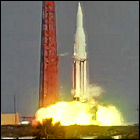 An unmanned Saturn I rocket is launched, the first practical demonstration of the multiple-engine design which has already been earmarked for future Apollo missions to the moon. Designed by expatriate German rocket engineer Werhner von Braun, the Saturn I is the first iteration of a family of heavy-lift rockets that will include the Saturn IB and the Saturn V; in this configuration, the Saturn I is the first stage of a Saturn V with no second stage.
An unmanned Saturn I rocket is launched, the first practical demonstration of the multiple-engine design which has already been earmarked for future Apollo missions to the moon. Designed by expatriate German rocket engineer Werhner von Braun, the Saturn I is the first iteration of a family of heavy-lift rockets that will include the Saturn IB and the Saturn V; in this configuration, the Saturn I is the first stage of a Saturn V with no second stage.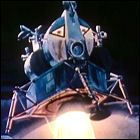 Weeks before an American astronaut first makes it to orbit, NASA unveils the design of the two Apollo spacecraft: a command/service module (large compared to the Mercury capsules Americans have already seen) and a completely un-aerodynamic lunar module whose unique shape, designed solely for landing on the moon, will never need to operate inside an atmosphere. Though further refinements in both designs are still to come, NASA has already decided on the basic shape of its crash lunar exploration program whose goal is to land a man on the moon before
Weeks before an American astronaut first makes it to orbit, NASA unveils the design of the two Apollo spacecraft: a command/service module (large compared to the Mercury capsules Americans have already seen) and a completely un-aerodynamic lunar module whose unique shape, designed solely for landing on the moon, will never need to operate inside an atmosphere. Though further refinements in both designs are still to come, NASA has already decided on the basic shape of its crash lunar exploration program whose goal is to land a man on the moon before 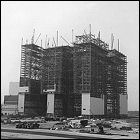 Construction commences on NASA’s massive Vehicle Assembly Building (originally named the Vertical Assembly Building), where the giant Saturn V rockets for Apollo lunar missions will be constructed, tested, and then rolled out to the launch pad atop huge mobile crawlers. Covering eight acres of land on Merritt Island, Florida, the building must withstand Florida’s notorious hurricane seasons (and protect any rockets under construction within) as well as the shockwaves of Saturn V rocket launches taking place only three miles away; special ventilation and humidity control systems have to be built as well, as the interior space is so voluminous that the building has its own internal weather! The VAB will later transition to the assembly of the Space Shuttle launch system elements and the Space Launch System boosters for the 21st century Orion program.
Construction commences on NASA’s massive Vehicle Assembly Building (originally named the Vertical Assembly Building), where the giant Saturn V rockets for Apollo lunar missions will be constructed, tested, and then rolled out to the launch pad atop huge mobile crawlers. Covering eight acres of land on Merritt Island, Florida, the building must withstand Florida’s notorious hurricane seasons (and protect any rockets under construction within) as well as the shockwaves of Saturn V rocket launches taking place only three miles away; special ventilation and humidity control systems have to be built as well, as the interior space is so voluminous that the building has its own internal weather! The VAB will later transition to the assembly of the Space Shuttle launch system elements and the Space Launch System boosters for the 21st century Orion program. A report prepared by the Future Projects Office of NASA’s Marshall Spaceflight Center and General Atomic, the nuclear power division of General Dynamics, outlines in great detail ways that existing rocket technology (namely the Saturn V, which will not fly until 1967) and theoretical nuclear pulse propulsion technology could be combined to facilitate exploration of the moon and Mars. (Though derived from the Project Orion studies of the late 1950s, the potential nuclear-powered NASA program suggested in this document is not referred to as Orion.) The report, over 174 pages, goes into great detail about crew module design, radiation exposure, ways to mitigate the inevitable ablation of the “pusher plate” at the rear of the vehicle that will absorb a series of nuclear explosions at close range and translate the energy released into forward thrust, and even possible catastrophic launch abort modes, many of which would qualify as at least a small nuclear disaster. Even the health effects on civilian onlookers of a successful launch are considered, from retinal damage caused by viewing high-altitude firings of the nuclear propellant explosions to fallout risks, as well as potential collateral damage to satellites and non-hardened computers resulting from repeated electromagnetic pulses. The mission profiles considered are constrained to lunar missions and missions to Mars. (It’s worth noting that, by the time of this report’s issuance, the Nuclear Test Ban Treaty has been ratified by both the U.S. and the U.S.S.R., making it illegal to put nuclear pulse propulsion into practice.)
A report prepared by the Future Projects Office of NASA’s Marshall Spaceflight Center and General Atomic, the nuclear power division of General Dynamics, outlines in great detail ways that existing rocket technology (namely the Saturn V, which will not fly until 1967) and theoretical nuclear pulse propulsion technology could be combined to facilitate exploration of the moon and Mars. (Though derived from the Project Orion studies of the late 1950s, the potential nuclear-powered NASA program suggested in this document is not referred to as Orion.) The report, over 174 pages, goes into great detail about crew module design, radiation exposure, ways to mitigate the inevitable ablation of the “pusher plate” at the rear of the vehicle that will absorb a series of nuclear explosions at close range and translate the energy released into forward thrust, and even possible catastrophic launch abort modes, many of which would qualify as at least a small nuclear disaster. Even the health effects on civilian onlookers of a successful launch are considered, from retinal damage caused by viewing high-altitude firings of the nuclear propellant explosions to fallout risks, as well as potential collateral damage to satellites and non-hardened computers resulting from repeated electromagnetic pulses. The mission profiles considered are constrained to lunar missions and missions to Mars. (It’s worth noting that, by the time of this report’s issuance, the Nuclear Test Ban Treaty has been ratified by both the U.S. and the U.S.S.R., making it illegal to put nuclear pulse propulsion into practice.)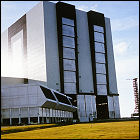 NASA’s massive Vehicle Assembly Building is completed at the spaceport rapidly taking shape on Cape Canaveral ahead of the Apollo lunar missions. Topped off at a total cost of $117,000,000, the VAB is where Saturn V rockets are assembled for the Apollo moonshots, and the huge, eight-acre building will later transition to the assembly of the Space Shuttle launch system elements and the Space Launch System boosters for the 21st century Orion program.
NASA’s massive Vehicle Assembly Building is completed at the spaceport rapidly taking shape on Cape Canaveral ahead of the Apollo lunar missions. Topped off at a total cost of $117,000,000, the VAB is where Saturn V rockets are assembled for the Apollo moonshots, and the huge, eight-acre building will later transition to the assembly of the Space Shuttle launch system elements and the Space Launch System boosters for the 21st century Orion program.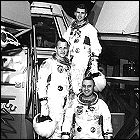 During a ground test of the Apollo 1 spacecraft, a fire breaks out in the 100% oxygen atmosphere of the Apollo capsule, leaving the crew – Virgil “Gus” Grissom, Ed White and Roger Chaffee – unable to operate or open the hatch. The searing heat burns through their oxygen hoses, suffocating the three astronauts in short order. Months of investigations and accusations follow, leading to changes of management at both NASA and North American Aviation, the aerospace company contracted to build the Apollo command/service module. Extensive redesign of the Apollo vehicle follows, including a switch to a nitrogen/oxygen atmosphere and a complete rethink of the hatch, and manned flights won’t resume until late 1968.
During a ground test of the Apollo 1 spacecraft, a fire breaks out in the 100% oxygen atmosphere of the Apollo capsule, leaving the crew – Virgil “Gus” Grissom, Ed White and Roger Chaffee – unable to operate or open the hatch. The searing heat burns through their oxygen hoses, suffocating the three astronauts in short order. Months of investigations and accusations follow, leading to changes of management at both NASA and North American Aviation, the aerospace company contracted to build the Apollo command/service module. Extensive redesign of the Apollo vehicle follows, including a switch to a nitrogen/oxygen atmosphere and a complete rethink of the hatch, and manned flights won’t resume until late 1968.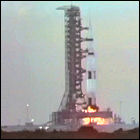 As questions over the safety of the Apollo spacecraft continue to rage, NASA performs the first “all-up” test of the Saturn V rocket with an unmanned launch officially designated Apollo 4. Unsure of what to expect, onlookers and press are stunned by the roar of the five huge F-1 engines; the vibrations cause CBS news anchor Walter Cronkite’s broadcast booth to partially collapse while he’s on the air – over three miles away. The entire vehicle performs flawlessly, propelling the empty (but active) Apollo command/service module to a distance of 10,000 miles before commanding it to return to Earth, simulating the speed and return angle of a vehicle returning from the moon.
As questions over the safety of the Apollo spacecraft continue to rage, NASA performs the first “all-up” test of the Saturn V rocket with an unmanned launch officially designated Apollo 4. Unsure of what to expect, onlookers and press are stunned by the roar of the five huge F-1 engines; the vibrations cause CBS news anchor Walter Cronkite’s broadcast booth to partially collapse while he’s on the air – over three miles away. The entire vehicle performs flawlessly, propelling the empty (but active) Apollo command/service module to a distance of 10,000 miles before commanding it to return to Earth, simulating the speed and return angle of a vehicle returning from the moon.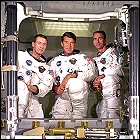 After a year of redesign and reorganization, NASA resumes manned flights with Apollo 7, the first of the successful Apollo flights. An 11-day Earth-orbit shakedown cruise for the Apollo command/service module, the mission becomes contentious when the three-man crew – Wally Schirra, Walt Cunningham and Donn Eisele – is loaded down with a jam-packed mission plan. Worse, Schirra comes down with a cold which quickly spreads to his crewmates in the enclosed biosphere of the Apollo command module. The flight’s technical goals are met with flying colors, though the crew’s snippy responses to ground controllers keep them off the crew rotation for future Apollo flights.
After a year of redesign and reorganization, NASA resumes manned flights with Apollo 7, the first of the successful Apollo flights. An 11-day Earth-orbit shakedown cruise for the Apollo command/service module, the mission becomes contentious when the three-man crew – Wally Schirra, Walt Cunningham and Donn Eisele – is loaded down with a jam-packed mission plan. Worse, Schirra comes down with a cold which quickly spreads to his crewmates in the enclosed biosphere of the Apollo command module. The flight’s technical goals are met with flying colors, though the crew’s snippy responses to ground controllers keep them off the crew rotation for future Apollo flights.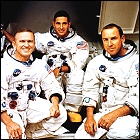 Moved ahead in the schedule due to ongoing difficulties with the construction of the lunar module, Apollo 8 lifts off from Cape Canaveral on a mission that represents NASA’s biggest gamble yet in the race for the moon: on only the second manned Apollo flight, astronauts Frank Borman, Jim Lovell and Bill Anders will go to the moon, orbit it in their command/service module, and return to Earth (the lunar module is still in the late stages of development). Mission planners plot out a free return trajectory – ensuring that without engines, Apollo 8 could loop around behind the moon and swing back toward home.
Moved ahead in the schedule due to ongoing difficulties with the construction of the lunar module, Apollo 8 lifts off from Cape Canaveral on a mission that represents NASA’s biggest gamble yet in the race for the moon: on only the second manned Apollo flight, astronauts Frank Borman, Jim Lovell and Bill Anders will go to the moon, orbit it in their command/service module, and return to Earth (the lunar module is still in the late stages of development). Mission planners plot out a free return trajectory – ensuring that without engines, Apollo 8 could loop around behind the moon and swing back toward home.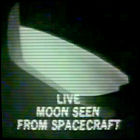 Broadcasting live black & white television pictures from lunar orbit on Christmas Eve, the crew of Apollo 8 delivers one of the most-watched broadcasts of 1968. As the surface of the moon rolls silently outside the windows of their command/service module, the astronauts take turns reading the first chapter of Genesis, dedicating it to “all of you on the good Earth.” After ten orbits of the moon, Apollo 8 fires its engine, putting it on a return trajectory to Earth; it splashes down safely three days later.
Broadcasting live black & white television pictures from lunar orbit on Christmas Eve, the crew of Apollo 8 delivers one of the most-watched broadcasts of 1968. As the surface of the moon rolls silently outside the windows of their command/service module, the astronauts take turns reading the first chapter of Genesis, dedicating it to “all of you on the good Earth.” After ten orbits of the moon, Apollo 8 fires its engine, putting it on a return trajectory to Earth; it splashes down safely three days later.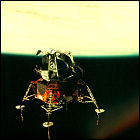 Apollo 9 lifts off on a ten-day mission to test the first lunar lander, but only in Earth orbit. Jim McDivitt and Rusty Schweickart put the lunar module, nicknamed Spider, through its paces, while David Scott mans the command module Gumdrop. This is the first flight of the completely non-aerodynamic lunar module, and various docking maneuvers and spacewalk scenarios are practiced. The crew returns to Earth in the Apollo command module, while Spider is left in a low orbit which decays two weeks later, allowing it to disintegrate in Earth’s atmosphere.
Apollo 9 lifts off on a ten-day mission to test the first lunar lander, but only in Earth orbit. Jim McDivitt and Rusty Schweickart put the lunar module, nicknamed Spider, through its paces, while David Scott mans the command module Gumdrop. This is the first flight of the completely non-aerodynamic lunar module, and various docking maneuvers and spacewalk scenarios are practiced. The crew returns to Earth in the Apollo command module, while Spider is left in a low orbit which decays two weeks later, allowing it to disintegrate in Earth’s atmosphere.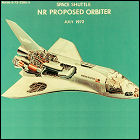 NASA formally asks various major players in the aerospace industry for proposals for what the agency sees as its two major projects for the 1970s: an orbiting space station and a reusable Space Shuttle to make routine flights from Earth to the station – which NASA hopes will be a “50 man space base” – and back again, with supplies, experiments, and new crew members. (Within mere weeks, the hypothetical station’s equally hypothetical crew will be downsized to a dozen.) In the event that the development curve on the Space Shuttle proves to be a long one, NASA says it will keep Apollo and even Gemini spacecraft in service to make flights to the station.
NASA formally asks various major players in the aerospace industry for proposals for what the agency sees as its two major projects for the 1970s: an orbiting space station and a reusable Space Shuttle to make routine flights from Earth to the station – which NASA hopes will be a “50 man space base” – and back again, with supplies, experiments, and new crew members. (Within mere weeks, the hypothetical station’s equally hypothetical crew will be downsized to a dozen.) In the event that the development curve on the Space Shuttle proves to be a long one, NASA says it will keep Apollo and even Gemini spacecraft in service to make flights to the station.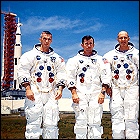 Apollo 10 lifts off for a dress rehearsal over the moon. Thomas Stafford, Gene Cernan and John Young fly a complete Apollo stack – both the command/service module and the lunar model – to the moon, conducting practice maneuvers in lunar orbit. Over eight days, the Apollo 10 crew does everything but land on the moon. With the mission requirements fulfilled, NASA announces that the next Apollo mission will attempt an actual landing.
Apollo 10 lifts off for a dress rehearsal over the moon. Thomas Stafford, Gene Cernan and John Young fly a complete Apollo stack – both the command/service module and the lunar model – to the moon, conducting practice maneuvers in lunar orbit. Over eight days, the Apollo 10 crew does everything but land on the moon. With the mission requirements fulfilled, NASA announces that the next Apollo mission will attempt an actual landing.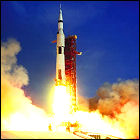 Apollo 11 lifts off, with astronauts Neil Armstrong, Buzz Aldrin and Michael Collins aboard. This is the first mission scheduled to attempt a landing on the moon, with Armstrong and Aldrin aboard the lunar module while Collins remains in orbit in the command/service module.
Apollo 11 lifts off, with astronauts Neil Armstrong, Buzz Aldrin and Michael Collins aboard. This is the first mission scheduled to attempt a landing on the moon, with Armstrong and Aldrin aboard the lunar module while Collins remains in orbit in the command/service module.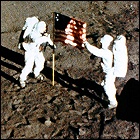 The Apollo 11 lunar module touches down in the Sea of Tranquility, a flat plain on the moon. Astronaut Neil Armstrong is the first human being to set foot on another body in the solar system, followed by “Buzz” Aldrin; the two spend roughly two and a half hours on the moon and gather nearly 50 pounds of samples of lunar soil and rock. This feat effectively ends the Cold War space race, though both the United States and the Soviet Union continue their lunar efforts: more Apollo missions are still on the schedule, and the Soviet continue trying to mount a successful launch of their giant N1 rocket.
The Apollo 11 lunar module touches down in the Sea of Tranquility, a flat plain on the moon. Astronaut Neil Armstrong is the first human being to set foot on another body in the solar system, followed by “Buzz” Aldrin; the two spend roughly two and a half hours on the moon and gather nearly 50 pounds of samples of lunar soil and rock. This feat effectively ends the Cold War space race, though both the United States and the Soviet Union continue their lunar efforts: more Apollo missions are still on the schedule, and the Soviet continue trying to mount a successful launch of their giant N1 rocket.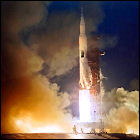 Apollo 12 lifts off, with astronauts Pete Conrad and Alan Bean set to become the next pair of human moonwalkers aboard the lunar module Intrepid, while Dick Gordon observes from orbit in the command/service module Yankee Clipper. The Intrepid crew is also assigned to deploy an instrument package called ALSEP (Apollo Lunar Scientific Experiment Package) which will be left on the surface even after their departure. The mission lasts ten days.
Apollo 12 lifts off, with astronauts Pete Conrad and Alan Bean set to become the next pair of human moonwalkers aboard the lunar module Intrepid, while Dick Gordon observes from orbit in the command/service module Yankee Clipper. The Intrepid crew is also assigned to deploy an instrument package called ALSEP (Apollo Lunar Scientific Experiment Package) which will be left on the surface even after their departure. The mission lasts ten days.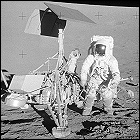 Astronauts Pete Conrad and Alan Bean land on the moon in the Apollo 12 lunar module Intrepid, a mere 600 feet away from the 1967 landing site of the unmanned Surveyor 3 probe. Pieces of Surveyor 3 are gathered for return to Earth to study the effects of prolonged exposure to the lunar environment. Conrad and Bean conduct two moonwalks, each lasting nearly four hours.
Astronauts Pete Conrad and Alan Bean land on the moon in the Apollo 12 lunar module Intrepid, a mere 600 feet away from the 1967 landing site of the unmanned Surveyor 3 probe. Pieces of Surveyor 3 are gathered for return to Earth to study the effects of prolonged exposure to the lunar environment. Conrad and Bean conduct two moonwalks, each lasting nearly four hours.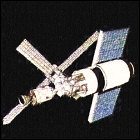 NASA formally cancels the planned Apollo 20 mission to the moon’s Copernicus crater in order to begin converting the upper stage of the mission’s Saturn V rocket into the Skylab space station, to be launched in the early 1970s. Construction of the Apollo command/service module and lunar module scheduled to fly this mission was halted before either vehicle was completed. The crew would have consisted of Stu Roosa, Paul Weitz and Jack Lousma; ironically, Weitz was transferred to the first Skylab crew, while Lousma was part of the second Skylab crew. Both later flew on shuttle missions.
NASA formally cancels the planned Apollo 20 mission to the moon’s Copernicus crater in order to begin converting the upper stage of the mission’s Saturn V rocket into the Skylab space station, to be launched in the early 1970s. Construction of the Apollo command/service module and lunar module scheduled to fly this mission was halted before either vehicle was completed. The crew would have consisted of Stu Roosa, Paul Weitz and Jack Lousma; ironically, Weitz was transferred to the first Skylab crew, while Lousma was part of the second Skylab crew. Both later flew on shuttle missions.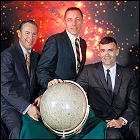 The third planned lunar landing mission, Apollo 13, lifts off. Astronauts Jim Lovell and Fred Haise are scheduled to walk in the Fra Mauro region of the moon. Command module pilot Ken Mattingly falls victim to a medical condition, leaving NASA to make a rare substitution, rotating the backup crew’s command module pilot, Jack Swigert, to the prime crew prior to launch.
The third planned lunar landing mission, Apollo 13, lifts off. Astronauts Jim Lovell and Fred Haise are scheduled to walk in the Fra Mauro region of the moon. Command module pilot Ken Mattingly falls victim to a medical condition, leaving NASA to make a rare substitution, rotating the backup crew’s command module pilot, Jack Swigert, to the prime crew prior to launch.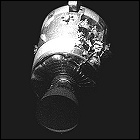 Halfway between Earth and the moon, a fuel cell rupture in the Apollo 13 service module causes a massive explosion. The crew has to activate the landing module, Aquarius, to use it as a “lifeboat”; the oxygen and power reserves of the command module, Odyssey, have been compromised by the explosion and must be preserved for re-entry. The crew endures extreme cold and must ration consumables to survive. Fortunately, there’s enough fuel in Aquarius’ descent stage to put the combined vehicle on a free-return trajectory, looping it around the far side of the moon for an immediate return to Earth.
Halfway between Earth and the moon, a fuel cell rupture in the Apollo 13 service module causes a massive explosion. The crew has to activate the landing module, Aquarius, to use it as a “lifeboat”; the oxygen and power reserves of the command module, Odyssey, have been compromised by the explosion and must be preserved for re-entry. The crew endures extreme cold and must ration consumables to survive. Fortunately, there’s enough fuel in Aquarius’ descent stage to put the combined vehicle on a free-return trajectory, looping it around the far side of the moon for an immediate return to Earth.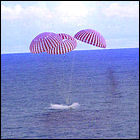 Having become the stuff of round-the-clock news coverage (though few media outlets bothered to cover any aspects of the mission before the emergency took place), the reactivated Apollo 13 command module Odyssey successfully reenters Earth’s atmosphere and returns its crew safely. (The lunar module, Aquarius, has been discarded in Earth orbit, where it eventually disintegrates, upon reentry; rather than landing on the moon, its fuel and air reserves have served the much more important function of keeping the crew alive.)
Having become the stuff of round-the-clock news coverage (though few media outlets bothered to cover any aspects of the mission before the emergency took place), the reactivated Apollo 13 command module Odyssey successfully reenters Earth’s atmosphere and returns its crew safely. (The lunar module, Aquarius, has been discarded in Earth orbit, where it eventually disintegrates, upon reentry; rather than landing on the moon, its fuel and air reserves have served the much more important function of keeping the crew alive.)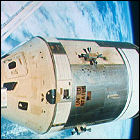 After the Congressional budget for the fiscal year of
After the Congressional budget for the fiscal year of 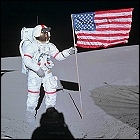 After nearly a year of examining the problems that nearly doomed the crew of Apollo 13, the third lunar landing is achieved by the crew of
After nearly a year of examining the problems that nearly doomed the crew of Apollo 13, the third lunar landing is achieved by the crew of 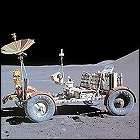 The Apollo 15 mission lifts off, carrying astronauts David Scott, James Irwin and Al Worden on a 12-day mission to the moon and back. Aboard the lunar module Falcon, Scott and Irwin become, respectively, the seventh and eighth men to walk on the moon, exploring the mountainous Hadley Rille region, while Worden pilots the command/service module Endeavour. The service module for this mission is equipped with a suite of sensors and instruments designed to be exposed to space in lunar orbit. Scott and Irwin become the first men to drive on the moon, covering over seven miles in the first lunar rover “moon buggy.”
The Apollo 15 mission lifts off, carrying astronauts David Scott, James Irwin and Al Worden on a 12-day mission to the moon and back. Aboard the lunar module Falcon, Scott and Irwin become, respectively, the seventh and eighth men to walk on the moon, exploring the mountainous Hadley Rille region, while Worden pilots the command/service module Endeavour. The service module for this mission is equipped with a suite of sensors and instruments designed to be exposed to space in lunar orbit. Scott and Irwin become the first men to drive on the moon, covering over seven miles in the first lunar rover “moon buggy.”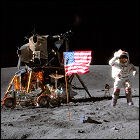 NASA launches the Apollo 16 mission to the moon, lasting 11 days total. Astronauts John Young and Charlie Duke descend to the lunar surface in the lander Orion, while Ken Mattingly pilots the command/service module Casper in orbit. Again, a lunar rover is tucked into one side of the lunar module, allowing Young and Duke to reach distances of 16 miles from their landing site. They spend a total of 20 hours walking on the moon’s surface, collecting over 200 pounds of soil and rock samples from the Descartes highlands region.
NASA launches the Apollo 16 mission to the moon, lasting 11 days total. Astronauts John Young and Charlie Duke descend to the lunar surface in the lander Orion, while Ken Mattingly pilots the command/service module Casper in orbit. Again, a lunar rover is tucked into one side of the lunar module, allowing Young and Duke to reach distances of 16 miles from their landing site. They spend a total of 20 hours walking on the moon’s surface, collecting over 200 pounds of soil and rock samples from the Descartes highlands region.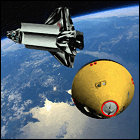 Space shuttle contractor North American Rockwell submits a safety study to NASA concerning safety and escape systems for the upcoming space shuttle, including a study of smaller vehicles with potential use as “lifeboats” in the event that a shuttle is unfit for return to Earth due to heat shield or other catastrophic damage. The various proposals, which include the possibility of permanently berthing an Apollo command module (another vehicle contracted to North American Rockwell) in the shuttle’s cargo bay for use as a lifeboat, are rejected by NASA due to the impact that each proposal would have on available space and weight for cargo.
Space shuttle contractor North American Rockwell submits a safety study to NASA concerning safety and escape systems for the upcoming space shuttle, including a study of smaller vehicles with potential use as “lifeboats” in the event that a shuttle is unfit for return to Earth due to heat shield or other catastrophic damage. The various proposals, which include the possibility of permanently berthing an Apollo command module (another vehicle contracted to North American Rockwell) in the shuttle’s cargo bay for use as a lifeboat, are rejected by NASA due to the impact that each proposal would have on available space and weight for cargo.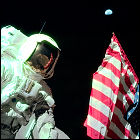 The final manned lunar landing mission lifts off atop a Saturn V rocket. Apollo 17 is the first mission to include a qualified geologist, Harrison Schmitt, in its crew; Gene Cernan and Schmitt descend to the surface aboard the lunar lander Challenger, where the last two men to walk on the moon spend a total of 22 hours exploring the Taurus-Littrow valley. For the third mission in a row, a lunar rover is stowed into one side of the lander. Astronaut Ron Evans orbits overhead in the command/service module America. The astronauts return on December 19th, bringing home nearly 250 pounds of lunar soil and rock samples.
The final manned lunar landing mission lifts off atop a Saturn V rocket. Apollo 17 is the first mission to include a qualified geologist, Harrison Schmitt, in its crew; Gene Cernan and Schmitt descend to the surface aboard the lunar lander Challenger, where the last two men to walk on the moon spend a total of 22 hours exploring the Taurus-Littrow valley. For the third mission in a row, a lunar rover is stowed into one side of the lander. Astronaut Ron Evans orbits overhead in the command/service module America. The astronauts return on December 19th, bringing home nearly 250 pounds of lunar soil and rock samples.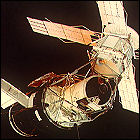 The first three-man Skylab crew lifts off to undertake a mission far different from the one for which they had trained. Their primary objective is now to save the crippled station from the damage it suffered during launch; as it is, Skylab is uninhabitable, with temperatures in its workshop and crew quarters soaring above 100 degrees, threatening to heat up items inside enough to fill the space with toxic gases. The first repair spacewalk takes place less than 24 hours after the crew arrives in an Apollo capsule, and succeeds in starting to drop the temperature inside.
The first three-man Skylab crew lifts off to undertake a mission far different from the one for which they had trained. Their primary objective is now to save the crippled station from the damage it suffered during launch; as it is, Skylab is uninhabitable, with temperatures in its workshop and crew quarters soaring above 100 degrees, threatening to heat up items inside enough to fill the space with toxic gases. The first repair spacewalk takes place less than 24 hours after the crew arrives in an Apollo capsule, and succeeds in starting to drop the temperature inside.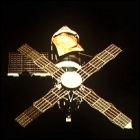 Having repaired and secured the damaged Skylab over the course of three spacewalks, the space station’s first three-man crew leaves the station and returns to Earth after 28 days in space, experiencing gravity after nearly a month of zero-G.
Having repaired and secured the damaged Skylab over the course of three spacewalks, the space station’s first three-man crew leaves the station and returns to Earth after 28 days in space, experiencing gravity after nearly a month of zero-G.